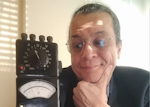Keysight’s Mike Hoffman talks about their Infiniium MXR-Series Mixed-Signal Oscilloscopes
Recently Keysight Technologies unveiled their Infiniium MXR-Series Mixed-Signal Oscilloscopes, presented as the first to combine the efficiency of an 8-in-1 bench solution with 8 analog channels at 6 GHz, and 16 simultaneous digital channels. It can reduce test bench and workflow complexity, as well as deliver accurate and repeatable multi-channel measurements, in a single instrument.
Testing advanced applications requires time- and frequency-domain equipment capable of simultaneous analog and digital channels, ideally with software enabled protocols, standards, built-in test assistance, and test-team remote collaboration. We recently met with Mike Hoffman over at Keysight to talk about the MXR Series, and why the company thinks it is such a force multiplier for the design engineer.
EE: OK Mike, let's start by going from the 30,000-foot level, and then we'll circle the landing field and land at your point. So in the case of challenges in development, let's look at someone designing today. Everyone expects more battery life, they expect better performance, higher efficiency, smaller form factors. There's a lot of pressure on the development engineer right now, isn't there?
Mike: “Oh, yeah. So, that's Moore's Law coming into play. It's very cliche, of course, but it's cliche because it's true. Things are becoming smaller and more efficient. Engineers are being asked to work with smaller voltages, tighter tolerances on those voltages, all with better performance, higher speeds, smaller form factor. The more devices crammed into one, so we're seeing the average mobile device with, let's say, 100 different power lines on it, powering various different blocks of technology inside the device, and all of these things have to be juggled and managed at the same time.”
“It’s not only that a device has such a voluminous amount of things that require testing, but that one piece of the design can affect other pieces of the design. Things like crosstalk or power supply induced jitter, or interference, wireless interference, or fast-rising edges, things like that. The predecessor of the MXR-Series came to market with a really strong message of signal integrity and low noise. There's a lot of pressure for our customers to try to find the tools that are accurate enough to keep up with the tight tolerances and requirements of their measurements.”
The test and measurement industry is constantly trying to stay one step ahead of the test challenges of our customers. So there's a lot of eating the dog food, right? Because we need good test tools to create a good product to help our customers test. A big driver of customers looking for test tools in this space is extremely high accuracy, extremely low noise, at small voltages and high frequencies, all the tough things at the same time.”
EE: Now, Mike, in this context, the MXR, the big advantage that was mentioned in the release was the integration of multiple tools. Now, how does that address the issues you were just referring to?
Mike: “Sure. So we're talking about all the really crazy, complex design challenges that oscilloscopes help solve, but there's also a lot of menial tasks, right? You get your first prototype back, is the thing even turning on correctly? Right? I know this voltage needs to be 2.375 volts plus or minus 50 millivolts, but is it even on? And you might pull out a DMM, maybe you need a function generator to simulate some sort of command signal and get your device to wake up.”
“So before you start really fine tuning and perfecting and getting those measurements, there's a lot of just general-purpose-style measurements that customers also need to deal with. That requires tons of equipment on the bench and having to pull out your say, digital voltmeter. Okay, where are the probes for it? Do I have the latest firmware? How do I navigate this menu again? How do you store it, asset, track it? Space on the bench, it's a lot of clutter.”
“So one thing that we did back in 2011 with our InfiniiVision X-Series scopes is start pulling in some of these basic tests tools and try to put them into one user interface, in one device, that only needs to be one device to calibrate, one device to update, one user interface to learn. So we have a basic voltmeter, a function generator, a 10-digit counter, a couple of different 10-digit counters actually, and then a couple more advanced tools like a real-time spectrum analyzer, a logic analyzer, and try to put them all into one box.”
EE: Got it. So now I've sat down, I've got the oscilloscope, what tools can I eliminate from the bench that I had to worry about before this arrived?
Mike: “Now, I will preface this by saying, I'm not saying that every MXR-Series customer can go throw away or trade in or recycle all their other tools. There's always going to be a place for dedicated test tools that are designed to be the best at what they do. We haven't actually taken the guts from a true volt DMM and put it into the scope. It's designed for that 95% case of, is the patient alive, I'm checking for a pulse. And in many cases, the tool gets the job done fantastically.”
“So as far as what the customer can eliminate from their bench, I hesitate to say they should eliminate anything. What I'm hopefully going to see from customers, is they don't need to pull that device out nearly as often. Maybe the 5% case they go, "Okay, I need to go hunt down the dedicated test tool with the dedicated performance of a purpose-built instrument." What I think from the bench perspective, they can probably get rid of their waveform generator and digital volt meter and their counter and put those into storage perhaps, or pass it to a different lab, and then they still have access to it in the case where they do need it.”
EE: Right. For example, if you wanted to do some development and you had your own lab in your basement or garage, this is a good way to have a general instrument that is good enough to be what you need.
Mike: “As Hewlett-Packard did back in the day. Still got pictures of Bill and Dave on our office walls to remind us of that. So yes, we are constantly not only trying to create the test tools for the companies that keep the lights on, like the big billion dollar companies that of course are a significant portion of our revenue, but we do like to keep that entrepreneur spirit alive too, and try to create tools that are affordable and usable for everybody and try to help accelerate innovation that way from the ground up. So yes, absolutely. This would be a fantastic all-in-one tool for a lab that's getting ready to start up and get going on some prototyping and developing.”
EE: Excellent. All right then, Mike, are there any last thoughts on this you'd to leave the readership?
Mike: That's a good question. Last thoughts. So the MXR-Series was really designed from the ground up, leveraging some of the best technologies that we've had out there. It's got the heart of our UXR-Series oscilloscope. So if you're reading this, you're probably a fan of test equipment, and you probably know about Keysight's UXR-Series, that over $1 million or Euro hyper-oscilloscope, it's like the supercar of oscilloscopes.”
“But we have the heart of that super scope in the MXR-Series, at an accessible price point, and in a usable, portable form factor. And then we've got some of the great instrument integration capabilities that we innovated almost a decade ago in the InfiniiVision class oscilloscopes, to give you an eight-in-one tool to help you see more, do more and save time. So really, that's what it's all about. Helping customers see more, do more, save time, and hopefully have a little fun along the way. I think oscilloscopes are fun, but maybe I'm crazy.


